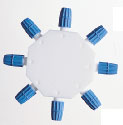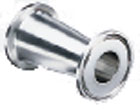Fittings Selection Guide
The world of biologics supplies is full of choices. And those choices aren’t merely down to personal preference: each piece must fit with every other as a seamless ecosystem for lab equipment to function properly.
At Masterflex, our concern is to make this process easier. This fitting guide will help you find the right type of fitting for your system.
How to Choose the Right Fittings
After you've decided on the right pump, chromatography system, or fermentation equipment, you'll want to make the right connections. The wrong fittings can cause problems such as:
- Leaks
- Unwanted flow restrictions
- Costly downtime
Choosing proper fittings allows your equipment to do the work that you intend it to do.
Selecting Your Fittings
-
Tubing Type
Barbed fittings work best with flexible tubing such as silicone or PharMed®. Compression fittings work well with rigid tubing such as PTFE or polypropylene.
-
Types of Materials
Fluids that are incompatible with fitting material may cause leakage or system damage. For highly corrosive fluids, PTFE fittings are best. See our Chemical Resistance Charts to check the material compatibility of your fluid.
-
Check Temperature and Pressure Conditions
Fluids that are incompatible with fitting material may cause leakage or system damage. For highly corrosive fluids, PTFE fittings are best. See our Chemical & Material Compatibility Database to check the material compatibility of your fluid.
Basic Fitting Types
![]()
Barbed Fittings slide into soft tubing. Tubing elasticity holds the tubing onto the fitting for low-pressure installations.

Cam Fittings are quick-disconnecting fittings to use with hose. Connect a female coupler to a male adapter and pull down the arms for a secure connection. Capable of withstanding high-pressure applications.

Chromatography Fittings are a type of compression fitting designed for HPLC and other high-pressure applications. These fittings withstand pressures as high as 1000 psi.

Compression Fittings have a nut that compresses rigid tubing against fitting body for high-pressure applications.

Luer Fittings are designed to work with microtubing and luer-type syringes. Standard-sized connecting ends make luer fittings, stopcocks, and manifolds completely interchangeable for surefire installations.

Pipe Fittings are threaded in NPT (National Pipe Taper), UNF (Unified Fine Thread), or BSP (British Standard Pipe) sizes for permanent, high-pressure pipe connections.

Quick Disconnect Fittings allow you to make and break tubing connections without separating tubing from fitting. Available with barbed, pipe, compression, and John Guest® connections.

Sanitary Fittings are designed for contamination-free tubing connections. Most of these autoclavable fittings meet FDA and USDA requirements and 3A Sanitary Standards.
Pipe Thread Sizes
Originally, pipes were specified with a standardized outside diameter (OD) and wall thickness so that the nominal pipe size would approximately equal the inside diameter (ID). Because this relationship between the OD, wall thickness, and nominal pipe size no longer holds true, NPT (National Pipe Taper) and UNF (Unified Fine Thread) inch scales are different from the standard English inch scale.
also offers BSP British Standard Pipe) fittings for connecting systems that use both NPT and BSP thread configurations. See the table below for a comparison of these two thread styles.
| Size | Threads per inch | |
| NPT | BSP | |
| 1/8" | 27 | 28 |
| 1/4" | 18 | 19 |
| 3/8" | 18 | 19 |
| 1/2" | 14 | 14 |
| 3/4" | 14 | 14 |
Certificates of Compliance
Look for the "Certificates” badge shown with applicable products to easily identify when a certificate of quality is available.
Our customer service teams can provide a certificate of resin or elastomer compliance for many of our fittings, tubing, and gasket products. You can request this FREE documentation at the time of purchase by checking the "compliance" option for a specific item.
Certificates list your company's:
- PO number
- Order reference number
- Catalog number
- Formulation/Compound
- Lot number (where applicable)
- Country of origin
Certificates also list the regulations and agencies the fitting, tubing, or gasket complies with, including:
- FDA
- USP
- USDA
- National Formulary
- NSF International
- GMP
- 3A
Follow Our Fitting Guide
Sourcing compatible parts can be difficult; it’s an important part of the lab construction process that can easily go wrong if incompatible parts are purchased. We make shopping for the right fittings easier. Our fittings guide is sure to help you find just what you need.